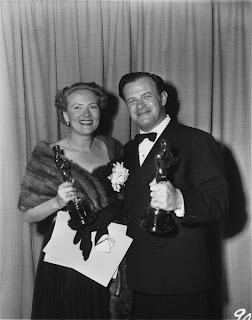The Hollywood Oscars Award Ceremony is a star-studded occasion which has become the pinnacle of the film awards season. It is one of the most glamorous media events in the world, pushing performers and film-makers into the media spotlight. To win an Hollywood Oscar is a dream come true, a marketing goldmine for the film industry, generating huge sales and profits for the stars, the studios and their employees.
The glittering extravaganza which we have become accustomed to has evolved from a much humbler beginning over 80 years ago. In 1927 the recently formed Academy of Motion Picture Arts and Sciences (AMPAS), created by a group of highly influential Hollywood Studio heads, discussed ways of honouring outstanding achievement in motion picture production in order to encourage higher standards in the industry.
The idea of creating a trophy or trophies was agreed on and eventually Los Angeles sculptor George Stanley was commissioned to create an appropriate design.>
As the USA and Hollywood grew to be the world's movie making hub, so did the stature of the awards increase. Eventually the Academy was recognised as the official body of world movie production and the Oscars became the pinnacle which every filmmaker and performer strove to reach.
The Statuette
The official name of the Oscar trophy is the "Academy Award of Merit". It is 13.5inches tall (34cm) and weighs 8.5lb (3.85kg.) Initially the statuette was made of solid bronze but during WWII the awards were made of plaster. Today's Oscars are made of a pewter-like alloy called Brittanium with gold plating to give the desired brilliant appearance, and is set on a black metal base.
Origins of the name "Oscar"
The term "Oscar" was originally a nickname coined and used during the early 1930's and later taken up by the Academy. The actual origins are somewhat mysterious. One theory came from Bette Davis who claimed it was named after her first husband, band leader Harmon Oscar Nelson. Another theory is that the Academy's first Executive Secretary, Margaret Herrick, thought the statuette reminded her of her "Uncle Oscar" (actually her nickname for her cousin, Oscar Pierce.) Whatever the truth, the trophy received official validation in 1939 when it was dubbed the "Oscar" by the Academy and so it has been called ever since.
The Design
When the Academy decided in 1929, that a suitable trophy should be created, one of the original members, Cedric Gibbons, art director of MGM, was entrusted with the design. He came up with the beautiful Art Deco classic design of a crusading knight with a sword, standing on a reel of film with five spokes. Each spoke represents one of the original branches of the Academy: Actors, Writers, Directors, Producers, and Technicians. In need of a model for his crusader, Gibbons was introduced by his wife, actress Dolores Del Rio, to a Mexican film director, Emilio Fernandez, who became the model for the statuette.
Gibbons's design was made in clay by sculptor George Stanley, and then the final Oscar trophy was cast in tin and copper and plated in gold. It has become one of the most instantly recognisable awards in the world, and it is the design still used today, with only the height of the pedestal being increased from 1945
The Voting System
An Oscar win gives a great boost in both financial and career terms for the winner. Hence the system of voting and film eligibilty has changed and become more streamlined over the years. When the Awards began in 1928, eligibility depended on a movie opening in Los Angeles between August 1st and July 31st of the year preceding the Award ceremony. To make the Award year more manageable – and more memorable - the system was changed after five years. The 1932-33 awards were given a longer qualifying period – 17 months from July 1932 and ever since then, beginning in 1934, all award eligibility has been based on the previous calendar year.
The original voting process was not secret and was open to abuse. Since 1935 the balloting process has been secret and has been managed by auditors Pricewaterhouse (now PricewaterhouseCoopers).
For more information on the Hollywood Oscars visit
Hollywood Oscars.com















_03.jpg)